Sacco and Vanzetti

| |
| Flag of Sacco and Vanzetti | |
| Motto: Good people don't need laws to act responsibly | |
| see below | |
| Region | Anarchism |
|---|---|
| Capital | Huxley-on-Sea |
| Official Language(s) | Many |
| Leader | None |
| Population | More than two billion |
| Currency | None |
| NS Sunset XML | |
Contents
Overview
Sacco & Vanzetti is a People's Commonwealth of islands and settlements stretching across two continents, currently with a combined total population of more than two billion.
The twin islands of Sacco and Vanzetti, as well as settlements in Kerla and First Outside, are in what has become known by some as the Greater Aperin continent but within the Commonwealth is referred to as Aperin. The archipelago known as The Malatesta Islands and settlements in Anarchy In Motion and The Wyrm Tribe are located in the tACA continent (now known as the geographic location of The Anarcho Communist Alliance).
In the 1960s forced re-settlement of much of the population of Sacco's capital city, Huxley-on-Sea, (formerly Port Huckslee) led to the major transportion to, and occupation of, a small chain of islands in the tACA continent.
However, the retention of historical, cultural and family links meant that when revolution came to the parent islands of Sacco and Vanzetti, it spread rapidly to the far-flung settlement. The citizens of the distant archipelago adopted the new name The Malatesta Islands and became equal partners in social and political organisation with their original home.
More recently, a number of further settlements have occurred in exchanges within the tACA continent under a scheme known as The Peoples International Proliferation Agreement.
It was following these additions that the communes agreed they should choose a more appropriate title to represent the areas where their shared culture and history were prevalent. All settlements and islands voted in favour of being known under the umbrella name of The People's Commonwealth of Sacco & Vanzetti. The short form of the title is Sacco & Vanzetti, abbreviated to S&V, the ampersand denotes the difference between the Commonwealth and the two islands of the same name.
Classified by the United Nations as "Civil Rights Lovefest" the lush ancient forests are a particular draw for tourists - and to those who bring their minds as well as their cameras, the style of government (or non-government) is intriguing.
Geography
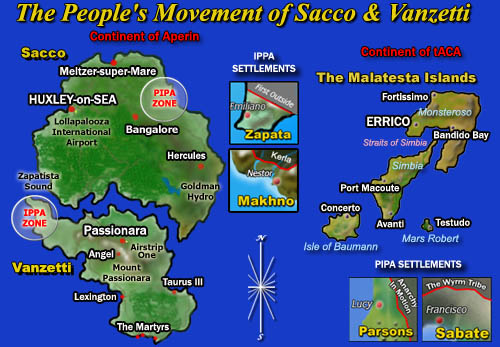
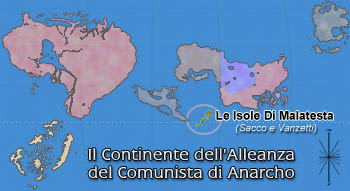
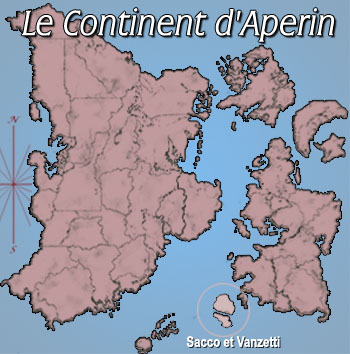
History
The 200-year known history of Sacco & Vanzetti includes long periods of colonial occupation and withdrawal, as well as attempts at corporate control, focused around plantations (tobacco - failed), mining (uranium - failed) and manufacturing (automobiles - failed).
During periods of external control much of the food for the peoples of the islands came from the sea, which was one of the key sources for the indigenous population even before the first Spanish colonists.
Sustainable fishing techniques and grounds have been developed alongside those of The Weegies, Free Outer Eugenia and Watfordshire.
Over two centuries the islands were held by the Spanish, the English, the French (briefly) and the Americans. The populace has been self-governing since the end of a bloody 15-year war of attrition against corporate control by motor giants the multi-national General Fjord company.
After the final withdrawal of the corporations, 18 years ago, the commonwealth was dogged by pockets of control by warlords, which took two years to eradicate.
Although essentially anarchist in spirit for many decades, the understanding of the last pieces of the jigsaw of delegated control from the people downwards came from revolutionaries within Free Outer Eugenia.
Folk Tales & Religions
The colonial history of Sacco & Vanzetti was marked by the establishment of an underground religious and political movement, centred around a creature which was known among the natives as the "Ton Ton Macoute".
Although little is known of this period, a few artifacts have been collected:
The first example is a framed miniature, which appears to be a religious icon of some sort. The second is a coin. There is no mention of such a coin in any historical studies concerning trade or currency and it is thought to have had a religious rather than a financial purpose.
The third is one of the few surviving original documents. It is believed to be an invocation, perhaps chanted as a children's rhyme.


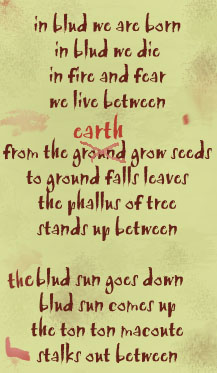
The Legend of the Rule of Three
The following text is an extract taken from the last entry of the recovered journals of gentleman anthropologist Jonathan Forshaw who came to the islands in the 1890s to study the traditions and customs of the indigenous population.
The natives in the interior of these islands are a study to behold. They appear all deference and submission (not but a single man appears unstooped whenever I am in their presence). But spite all this nodding at command their movement to fulfill orders is sluggish and hints even at disrespect.
None talks but that you question him direct and even then will not look you in the eye, as a man would, but shifts his feet and murmurs into his chest until you charge him to “speak up, speak up”, as you would a child.
It is only through the most painstaking and, it must be admitted, frustrating persistent questioning that anything of the heathen traditions of these savages can be unravelled. More than once I have wished a company of King’s Own Highlanders was at hand to whip the history out of them. (Although, of course, it is many years since the Highlanders have marched proud here, the islands now run by some despotic foreigners, not much better than the natives lounging in the villages).
Imagine my delight then that in this present sortie amidst these villages I have drawn my most valuable find to date. A quaint artefact no less! And the man who brought it to me must have been in rum as he explained the full meaning of the trinket he brought.
It seems it is something known as a Rule of Three – a tribal miscreant, guilty of some misdemeanours in a village, would, one day, find such a token bestowed upon him. (The first may come as a gift, or handed by an elder) It is looked on as somewhat of a warning.
Now, if the miscreant does not heed the first token and persists in his ways, a second will arrive, this time as if by accident, jumbled in his bedrags or slipped unseen into his pocket, or his bowl of soup or such. This second is a warning that the third token, called, I believe, a “Ton Ton Macoute” is on its way to him and he must flee, fly and runaway, for the third will mean his death.
Of course I was delighted that I should actually have got my hands on one of these trinkets as these islands have been most tedious in their lack of fruitfulness for the educated historian.
For weeks I had found nothing of note that could sit as an exhibit upon my return to the civilised world and then, having been given one of these trinkets by the old man, it was but the next day when I chanced upon a second that had somehow become wrapped in my linen.
It is with some impatience that I now seek for a so-called “Ton Ton Macoute” for that will give me the set of three and as marvellous a collection as these tawdry islands are likely to spew forth.
Tomorrow I shall find and question this old man most persistently – tonight I have finished my journal entry and shall walk out into the jungle for a spell before settling into my tent.
Lies, Half-truths & Pirate Publishing
The only extensive document related to the Ton Ton Macoute is a discredited, badly-written, badly-spelt, poorly-translated children's book called La Temps des Passions (sic). This was published by the Shiree Pirate Press, based in Watfordshire, and claimed to be a collaboration between the Ton Ton Macoute and The Avatarist.
Even these tacky and untrustworthy products are now extremely rare. They appear to have no collectible value and the primitive printing process used in their production made the pages unsuitable as firelighters.
An example of one of the scrawled and childish illustrations and a short extract from the text is provided below:
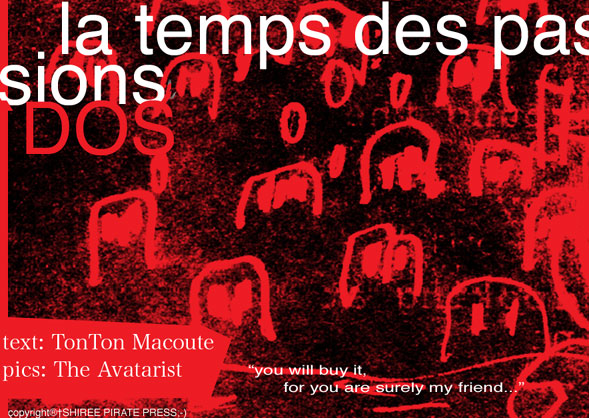
But Lorna knew her god was not here. No almighty of the meek dare nuzzle amidst the brimstone passion of these Zephaniah peoples. No New Testament compassion among these worshippers. Here was all blood and revenge and slaughter. Here was a God of passion and fear. Her words murmured the rituals of a lesser god. Deep inside, her heart trembled to the passion of a greater faith.
People
The Commonwealth enjoys a diverse racial and cultural mix, mainly due to the number of occupations over the centuries by different colonists who brought their own "under-classes" as either bonded or wage-bonded servants.
When not partying or working (Sacco & Vanzettians usually have two regular areas of work, one of which is manual) they generally enjoy pondering pure mathematics as a pastime, which is probably why chess is played throughout the Commonwealth.
Much of the partying expertise comes from natural inclination and the close influence of the peoples of Watfordshire.
Media
Citizens throughout the Commonwealth share a love of media of all sorts. The absence of licensing controls brings forth a rich crop of new products almost daily, most of which run for a short period as the people running them find something else to do with their leisure time.
Over the past decade a significant movement has grown in favour of the establishment of more regular media channels and the communes have accepted that activity in any one of these can be considered as meeting work requirements. The impact of this has been twofold. Firstly, the newspaper The People’s Blast, the radio station S&V Islands Radio FM and the television station S&V Satellite TeeVee are seen as the base media for the Commonwealth. Secondly, the establishment of these products means others can justifiably describe themselves as pirate products, a branding which offers a great deal of attraction to readers, listeners and viewers.

The People’s Blast began publishing in the very first days of revolution and is still a much-loved newspaper, as can be seen by the constant protests and outcries over its content, its style, its production and distribution, its staff and, most of all, its editor.
In the early days of regular publication, after the revolution, the editorship was rotated among the staff on a monthly basis. However, many found they could not face the mountains of mail, telephone calls from irate readers and arguments whenever they were out in public.
The rotation system was replaced by the election of a permanent editor.
Bluff, opinionated and outspoken, Johnny Kubrick was elected, the staff believing his iron nerve and thick skin would serve him well in the position. Kubrick’s other place of work was a pig farm and it was commonly said that he had acquired characteristics similar to his charges, particularly when debating issues.
But in less than a year, he had quit the post and moved to a remote mountain community to keep bees and to study their community spirit.
For many months The People’s Blast ran without an editor, which caused an even greater furore as readers felt there was not a proper point of contact for them to air their views.
In the end, a committee of readers and staff was able to persuade Xi Chunder to become editor. Chunder had been, and still is, first mate of the trawler Daisymast, a boat renowned for its long service at sea, calling in to harbour only to drop its catch before returning to the deep blue. Fifteen years later Chunder is still editor. Regular readers and the staff are united in their condemnation of rumours that Chunder was lost overboard in particularly bad weather 13 years ago.

A phantasmagoria of music, debate, phone-ins, plays, quizzes and quick quips, S&V Islands FM Radio is the delight of most citizens. Many a street café debate has been sparked by conflicting views about whether the station is a parody or a genuine debacle of taste, common sense and decency. Many a late-night brawl has ended with the issue still unsettled.
Perhaps its greatest star is presenter Roo McGruder. Her claim to broadcasting fame is based not only on 27 years of being on air but also that she once completed a mighty 72 hours of non-stop live radio. Many listeners who witnessed the event contend she was more comprehensible after three nights without sleep than she has been throughout the rest of her career.
Another favourite slot is Philosophy Hour featuring Big Red and Nuke War Dave. The conspiracy theory debate concerning Karl Marx as the love child of Pocahontas and Benjamin Disraeli, 1st Earl of Beaconsfield, still defies all chronological and genetic fact to top the bill of the greatest number of listeners in the station’s history.

Bizarrely, S&VSTV began life as a unit within the Buenaventura Durruti Academy of Streetfighting, alongside the shadowy Angry Brigade and Project Mayhem. It was the brainchild of media expert Nando Santa, who believed satire would become the post-modern instrument of revolution.
As the channel came together, it grew rapidly beyond its original concept and became an independent service months before it was on air.
The first show, broadcast throughout the continent, won plaudits from many peoples despite initial technical problems which brought the channel to a halt for a number of hours.
Fishing Fleets
The Commonwealth has four distinct fishing fleets: the Southern Fleet, based in Vanzetti, the Northern Fleet and Western Fleet, based in Sacco, and the Malatesta Fleet.
The Southern Fleet uses the three village ports which comprise The Martyrs at the most southerly tip of the island of Vanzetti and maintains fish nurseries off the western coast close to the town of Lexington and another along the eastern coast.
Not surprisingly, given that crews are mostly Vanzettians, the fleet has a perhaps undeserved reputation for aloofness. Although historically they have shown comradeship throughout the Commonwealth, their choice of ports in the coldest, most windblown villages is often seen as a statement of their rugged individuality.
The Northern Fleet, operating from Meltzer-super-Mare on Sacco, maintains fish nurseries to the east of the island. As it is the fleet most commonly used by overseas travellers it is renowned for the easy-going nature of most crews – and, a little unfairly, is thought of as the soft option for service.
The Western Fleet, operating from the main city of Sacco, Huxley-on-Sea, does not currently maintain a nursery, which is a source of much debate and contention among the various communes of the Commonwealth.
Proud of its regular contact with dignitaries, politicians, military personnel and diplomats, crews of the Western Fleet play down an incident in which they faced off a Ruhr taskforce and the subsequent sinking of Ruhr aircraft carrier Rapier. One experienced female trawler captain shrugged off the incident as “just bad driving”.
The Malatesta Fleet is organised with mixed crews from all four islands. Some communes are concerned that this arrangement leads to more debating than fishing. However, citizens are working to identify problems and find solutions.
